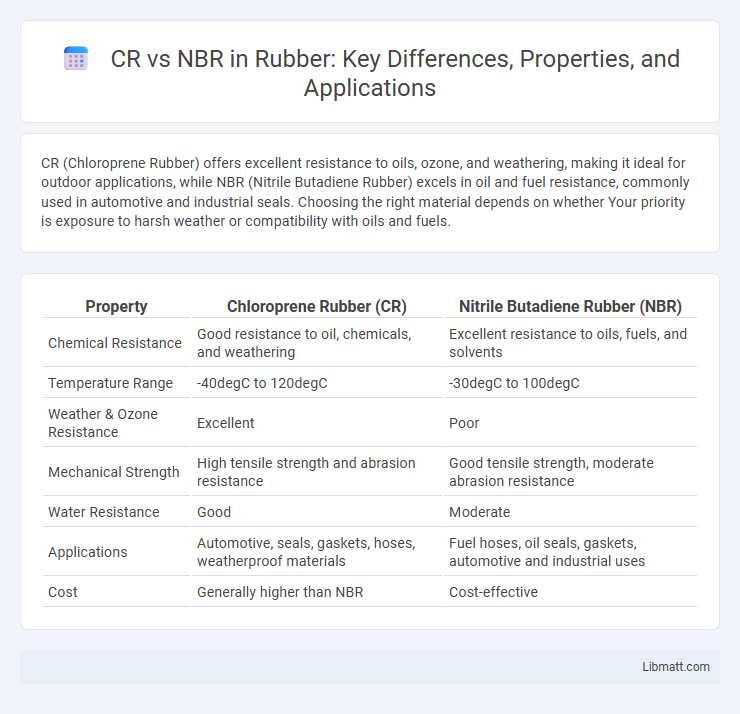CR (Chloroprene Rubber) offers excellent resistance to oils, ozone, and weathering, making it ideal for outdoor applications, while NBR (Nitrile Butadiene Rubber) excels in oil and fuel resistance, commonly used in automotive and industrial seals. Choosing the right material depends on whether Your priority is exposure to harsh weather or compatibility with oils and fuels.
Table of Comparison
| Property | Chloroprene Rubber (CR) | Nitrile Butadiene Rubber (NBR) |
|---|---|---|
| Chemical Resistance | Good resistance to oil, chemicals, and weathering | Excellent resistance to oils, fuels, and solvents |
| Temperature Range | -40degC to 120degC | -30degC to 100degC |
| Weather & Ozone Resistance | Excellent | Poor |
| Mechanical Strength | High tensile strength and abrasion resistance | Good tensile strength, moderate abrasion resistance |
| Water Resistance | Good | Moderate |
| Applications | Automotive, seals, gaskets, hoses, weatherproof materials | Fuel hoses, oil seals, gaskets, automotive and industrial uses |
| Cost | Generally higher than NBR | Cost-effective |
Introduction to CR and NBR
CR (Chloroprene Rubber) offers excellent resistance to oils, chemicals, and weathering, making it ideal for automotive and industrial applications. NBR (Nitrile Butadiene Rubber) excels in resistance to fuels, oils, and lubricants, commonly used in fuel hoses and seals. Both elastomers provide durable performance but differ significantly in chemical resistance and flexibility.
Chemical Structure Comparison
CR (Chloroprene Rubber) features a polymer backbone with alternating double bonds and chlorine atoms, enhancing its chlorine content and chemical resistance. NBR (Nitrile Butadiene Rubber) consists of copolymerized butadiene and acrylonitrile units, with polar nitrile groups that influence oil and fuel resistance. The presence of chlorine in CR provides superior resistance to ozone and weathering, while the nitrile groups in NBR offer enhanced compatibility with hydrocarbons due to their polar nature.
Key Properties of CR
CR (Chloroprene Rubber) exhibits excellent resistance to ozone, weathering, and aging, making it ideal for outdoor applications. It demonstrates superior flame retardancy and good chemical resistance against oils and solvents. CR also offers moderate mechanical strength and flexibility, enabling its use in seals, gaskets, and automotive parts.
Key Properties of NBR
NBR (Nitrile Butadiene Rubber) is renowned for its exceptional resistance to oils, fuels, and chemicals, making it ideal for automotive and industrial applications. This synthetic rubber offers excellent abrasion resistance and good mechanical properties, including high tensile strength and elasticity under varying temperatures. Your choice of NBR ensures durability in harsh environments where exposure to petroleum-based fluids is common, outperforming CR (Chloroprene Rubber) in oil resistance.
Applications of CR
CR (Chloroprene Rubber) is widely used in automotive parts, roofing membranes, and adhesives due to its excellent weather, ozone, and chemical resistance. Its high resilience and flexibility under extreme temperatures make it ideal for gaskets, hoses, and coatings in industrial applications. CR also serves in specialized protective gear and electrical insulation where durability and flame retardancy are critical.
Applications of NBR
NBR (Nitrile Butadiene Rubber) is widely used in automotive seals, fuel hoses, and oil-resistant gloves due to its excellent resistance to oils, fuels, and chemicals. Its high abrasion resistance and durability make it suitable for industrial gaskets, O-rings, and conveyor belts exposed to harsh environments. NBR's versatility in applications where oil and grease resistance is critical distinguishes it from CR (Chloroprene Rubber), which is preferred for weather and ozone resistance.
Advantages of CR
CR (Chloroprene Rubber) offers superior resistance to oils, chemicals, and weathering compared to NBR (Nitrile Butadiene Rubber). Its excellent ozone and flame resistance make it ideal for automotive, industrial, and outdoor applications. CR's enhanced durability and elasticity contribute to longer service life in harsh environmental conditions.
Advantages of NBR
NBR (Nitrile Butadiene Rubber) offers superior resistance to oils, fuels, and chemicals compared to CR (Chloroprene Rubber), making it ideal for automotive and industrial applications requiring durable sealing solutions. Its excellent abrasion resistance and high tensile strength enhance the lifespan and reliability of components exposed to harsh environments. You benefit from NBR's cost-effectiveness and versatility in temperature ranges from -40degC to 120degC, ensuring optimal performance in demanding conditions.
CR vs NBR: Performance Comparison
CR (Chloroprene Rubber) offers superior resistance to ozone, weathering, and moderate oil exposure compared to NBR (Nitrile Butadiene Rubber), which excels in fuel and oil resistance with better chemical stability. Your choice between CR and NBR should consider the application environment; CR is ideal for outdoor, oil-resistant needs, while NBR performs better in environments requiring high oil and solvent resistance. Mechanical properties like tensile strength and flexibility also favor CR for dynamic applications, whereas NBR provides better abrasion resistance in static conditions.
Choosing Between CR and NBR
Choosing between CR (Chloroprene Rubber) and NBR (Nitrile Butadiene Rubber) depends on specific application needs such as chemical resistance, temperature range, and durability. CR offers excellent weather, ozone, and flame resistance, making it ideal for automotive and industrial seals exposed to harsh environments. NBR provides superior resistance to oils, fuels, and chemicals, making it the preferred choice for fuel hoses, gaskets, and gloves in oil-related industries.
CR vs NBR Infographic

 libmatt.com
libmatt.com